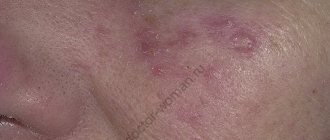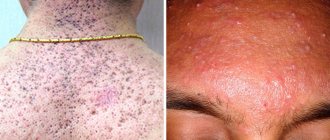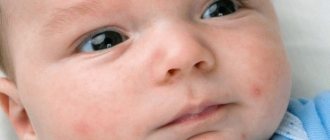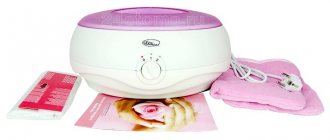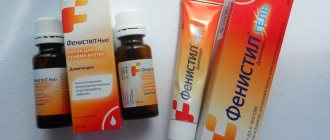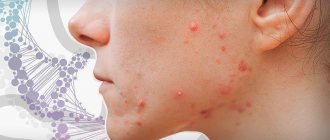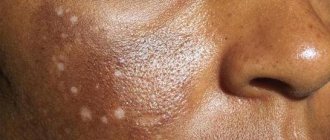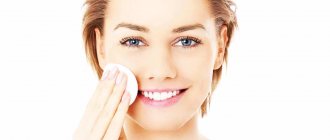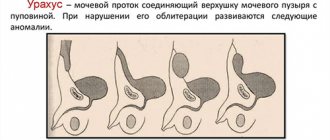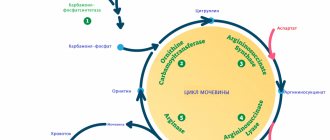Skin xerosis – abnormal dryness of the upper layer of the skin, caused by changes in the hydrolipid balance of the skin. It manifests itself as a dry, rough structure of the surface of the skin. The skin becomes cracked, inflamed, and infected. With the disease, the entire spectrum of pathological skin changes is observed: disturbances in sebum secretion, sweating, skin lipids, amino acid deficiency, and a feeling of discomfort. The condition is constantly accompanied by itching, which reduces the patient’s quality of life.
Why does the skin need water?
Moisture ensures skin elasticity, firmness and nourishment of skin cells. The level of hydration depends on the condition of the upper layer of skin and the amount of sebum secreted. These two factors are responsible for moisture exchange. Fat and the moderate stratum corneum form a lipid film on the skin; this film prevents moisture from leaving the skin and the environment from greatly influencing the condition of the inner skin. The absence or weakening of the lipid film, caused by age or external aggressive environmental factors, leads to excessive evaporation of moisture, and therefore to dry skin. It also negatively affects blood microcirculation and skin ventilation. Due to the lack of the required amount of moisture, the skin becomes dry and flabby.
Skin care for face and body
There is no universal method of care. It needs to be selected depending on age, gender and other characteristics of the body. For example, women have thin skin, while men have more active sebaceous glands.
And even for a specific person, it is hardly possible to choose a single care regimen for all skin. The body is more prone to dryness than the face, but it is easier to tolerate active influences - peelings and massages. And the area around the eyes requires light textures and delicate handling.
Moreover, all cosmetic procedures have a temporary effect and eliminate the consequences, not the causes. To achieve healthy skin on the face and body, the body needs to be cleansed and moisturized from the inside.
Causes of dry skin
In modern medicine and cosmetology, it is customary to distinguish two types of dry skin:
- acquired dry skin;
- determined by the constitution of the body.
Acquired dry skin becomes this way due to the aggressive effects of external factors. Dry skin can be caused by excessive ultraviolet radiation, hypothermia, high ambient temperatures, constant exposure to wind and low air humidity. Dry skin can also occur as a result of various therapeutic procedures, too aggressive peeling, or skin rejuvenation using dermabrasion.
Acquired dry skin is possible due to the use of azelaic acid, retinoids or other drugs containing alcohol.
There is another classification of dry body skin:
- good skin tone;
- low skin tone.
Good tone of dry skin is usually elastic and smooth matte skin. This is observed on skin that has no wrinkles, but sensitivity to external irritants is very high. If dry skin has good tone, regular cosmetic care is required. Usually appears in young people.
Low skin tone is characterized by its thinness, this is especially noticeable around the mouth and eyes. As a rule, low dry skin tone occurs in older people. Old age is also the most common cause of dry skin. After 40 years, various hormonal changes begin to occur in the body.
Over time, insufficient water intake can play a significant role in the development of dry skin. To maintain a normal state of skin moisture, according to all leading doctors and cosmetologists in the world, a person needs to drink up to 2 liters of clean water per day. A sufficient amount of water allows you to restore the balance of skin moisture, which evaporates during the day, which has a positive effect on the general condition of the human body.
Bad habits, such as drinking alcohol and smoking, leave their mark on all human organs and also greatly affect the condition of the skin. Toxins and other substances contaminate microvessels and complicate the circulation of moisture in the skin.
All causes of dry body skin can be divided into internal and external.
Internal reasons include:
- The skin may become dry due to hormonal imbalances (hypothyroidism, menopause, diabetes, pregnancy);
- Due to partial dehydration of the body, which occurs due to impaired drinking, indigestion, diarrhea, vomiting, etc.;
- A sharp metabolic disorder in the body;
- For chronic renal failure;
- For diseases of the central nervous system;
- Due to diseases of the gastrointestinal tract;
- For autoimmune diseases;
- For iron deficiency anemia;
- During the natural aging process of the skin;
- With chronic hypovitaminosis, in particular with a lack of vitamins A and E;
- With a long course of treatment with antibiotics and certain medications;
- Due to lack of nutrients and exhausting diets;
- Excessive consumption of coffee and strong tea;
- Due to bad habits (smoking, alcohol);
- Regular stress.
External reasons, in turn, include the following:
- Prolonged exposure to dry climates;
- Strong and prolonged exposure to the sun;
- Exposure to household or industrial chemicals;
- Improper skin care: abuse of alkaline soap, alcohol lotions, household chemicals, aggressive cosmetics, frequent pinning;
- Working with soil, etc. without protective gloves;
- Work at elevated temperatures (hot shops).
Vitamins for facial skin
What is the most important vitamin for skin? Some consider vitamin E the most effective for facial skin, others can spend hours explaining why vitamin C is useful. There is no need to look for a winner: it is better to focus on the question of how to make facial skin healthy, clean and radiant. It is important to remember the main vitamins responsible for her condition.
| Vitamin | Action | Result |
| A | Starts the process of cell renewal, controls the functioning of the sebaceous glands | Tightened skin, reduced acne and oily shine |
| B1 | Slows down the aging process, smoothes the relief of the dermis | Elastic skin, eliminating fine wrinkles |
| B2 | Regulates metabolism and is responsible for regeneration | Even tone, elimination of inflammation and irritation |
| B3 | Activates fibroblasts, reduces the activity of sebaceous glands | Firmer skin, reduced acne |
| B5 | Promotes regenerative processes, reduces inflammation | Healing damage, smoothing grooves and creases |
| B6 | Helps absorb nutrients, stimulates the removal of excess fluid | Reducing swelling, protecting against premature aging |
| B7 | Participates in the metabolism of fatty acids, forms a framework for the epithelium | Fresh complexion and elastic skin |
| B9 | Has an antioxidant effect, promotes the synthesis of amino acids | Eliminate acne, prevent pigmentation |
| B12 | Enriches the skin with oxygen and prevents dullness | Improving complexion, evening out tone |
| C | Blocks the action of free radicals, strengthens blood vessels and capillaries | Clean pores, smooth out fine wrinkles |
| D | Slows down the aging process, participates in collagen synthesis, improves metabolism | Elimination of redness and peeling, prevention of premature wrinkles |
| E | Supports the lipid mantle, has a lifting effect | Elimination of dryness, reduction of wrinkles on the face, appearance of a healthy glow |
| F | Protects against ultraviolet radiation, neutralizes free radicals | Firm and moisturized skin, reduced swelling, prevention of inflammation and allergies |
Symptoms of dry skin
Typically, dry body skin is a seasonal phenomenon, but if you do not react in time and take measures to eliminate this disease, it can become chronic. The general symptoms of dry skin differ significantly from the patient’s lifestyle, as well as climatic conditions. But we can highlight some of the main ones:
- After water procedures, there is a feeling of tightness of the skin;
- Externally, the skin becomes wrinkled and dehydrated;
- The skin looks rough;
- Complaints of severe itching;
- Peeling of the skin of varying severity;
- Cracks appear on the skin, which sometimes bleed and cause pain;
- Redness in various areas of the skin.
In what cases should you immediately seek medical help:
- Despite home measures to eliminate symptoms, the patient's condition does not improve;
- Dry skin becomes very red;
- Itching interferes with normal sleep;
- Formation of ulcers and wounds due to scratching;
- Severe peeling of the skin over large areas.
Diagnosis of dry body skin
Dry skin can occur with some more serious skin conditions. And they can only be identified through a full diagnosis and some tests.
- Follicular curatosis, which causes small, very acne-like pimples on a person's arms, legs and buttocks. A large number of these formations on the skin give it a very rough and dry appearance, like sandpaper. Often the pimples are flesh-colored, but when inflamed they will be red;
- With ichthyosis, skin cells peel off profusely, forming very thick scales that look more like fish scales. Multifaceted small scales are white or even brown. This disease can cause very deep and painful fissures in the body;
- Xerotic eczema also causes numerous cracks in the skin and dryness. The skin with this disease is constantly inflamed and bleeding. This is accompanied by severe itching;
- Psoriasis also manifests itself as dry and flaky skin on the body. It often manifests itself in a more complex form, when an infection is attached to the inflamed areas.
Skin xerosis. Part 2: treatment
Dry skin is a constant symptom of various skin diseases, such as atopic dermatitis, psoriasis, eczema, etc. It has now been proven that the constant use of combined moisturizing and lipid-restoring skin products is an essential component in the treatment of many dermatoses [1]. Restoring the damaged epidermal barrier becomes a priority for dry skin. The higher the skin's permeability to water, the deeper the surfactants (surfactants) of detergents, microbes and toxins penetrate into it, causing an inflammatory reaction and the formation of free radicals in the skin. Dry skin is cyclical in nature with an age-related tendency to worsen the condition, so rational cosmetic care adapted to the physiology and structure of the skin is very important. Moisturizers reduce the subjective feeling of tightness, dryness, discomfort, increase the elasticity and tolerance of the skin, even out the microrelief and color of the skin, and strengthen the water-lipid mantle.
The increase in the number of moisturizers with different mechanisms of action occurs in parallel with increasing knowledge about the physiology of the stratum corneum. The study of the epidermal barrier (primarily the lipid matrix) led to the creation of a new therapeutic direction in dermatology - “corneotherapy”. “Corneotherapy” - “treatment of the stratum corneum” (from Latin corneum - horny and English therapy - treatment). It was proposed by the famous American dermatologist Albert Kligman, who has the honor of discovering the role of retinoids in the treatment of acne. A. Kligman became a pioneer in research into the physiology of the outer skin, which led to the development of the concept of the “living stratum corneum”.
You can eliminate dryness of the stratum corneum in various ways:
1) creation of an occlusion on the skin surface that prevents transepidermal water loss (TEWL); 2) use of replacement therapy; 3) use of emollients; 4) creation of osmotic humidification; 5) restoration of the epidermal barrier; 6) use of hygroscopic agents; 7) activation of aquaporin synthesis.
Creation of an occlusion on the skin surface that prevents transepidermal moisture loss. Probably the oldest method of moisturizing is the use of substances that create a waterproof film on the surface of the skin that prevents evaporation. In this way, a compress effect (occlusive dressing) is achieved, which restores and improves the diffusion of fluid from the capillaries of the dermis into the epidermis. Moisturizers with an occlusive effect are used mainly in dermatology, in the treatment of diseases accompanied by increased skin dryness and inflammatory processes, in cosmetology after plastic surgery, such as skin resurfacing, and also to protect the skin during frequent contact with detergents. It is important to remember that this method can be used when the properties of intercellular lipids are undisturbed. This method allows you to capture and redistribute moisture throughout the entire thickness of the epithelium. Although, according to Koshevenko Yu. N. (2008), such occlusion leads not only to a slowdown in the restoration of the barrier function of the epidermis, but also to a disruption in the secretion of lamellar bodies [2].
Occlusive type humidifiers include:
1) fatty acids (lanolin, stearic, etc.); 2) fatty alcohols (lanolin, palmitic, caprylic, etc.); 3) hydrocarbon oils and waxes (vaseline, paraffin, mineral oils, squalene); 4) phospholipids; 5) waxes of plant and animal origin (carnauba wax, lanolin); 6) solid vegetable oils (cocoa, shea, coconut, macadamia, etc.).
Traditionally, in dermatology, for dry, non-oily skin, lipophilic creams of the “water in oil” type are used; such creams are difficult to wash off and, due to the occlusive effect, do not allow the skin to lose moisture and protect against overdrying [3].
Vaseline is the most reliable and proven occlusive coating in dermatology. It is used in products intended to moisturize the skin for psoriasis, atopic dermatitis, etc., as it retains moisture in the skin very well. On the one hand, Vaseline creates a physical barrier to evaporating moisture, on the other hand, it “glues” the horny scales together, resulting in a decrease in the area of contact between the intercellular spaces and the air, which inhibits the process of transepidermal water evaporation. A gel containing 5% petroleum jelly reduces TEWL by 98%. However, moisturizing the skin with Vaseline can be regarded as passive, since it only helps to retain the moisture that is already in the stratum corneum. Another option for hydration - active - is that hygroscopic substances that are capable of binding and retaining water through ionic interactions are introduced into the stratum corneum [4].
Vaseline is currently practically not used in cosmetology, since it is subjectively uncomfortable to use: it is poorly absorbed, shiny, and leaves a feeling of a sticky film. Some cosmetologists recommend Vaseline-based creams to protect the skin during the winter. However, studies have shown that petroleum jelly creates a deceptive sensation of warmth and thereby increases the likelihood of frostbite [5, 6].
Moisturizers intended for the winter period often include saturated fats (goose, badger, bear). Cosmetics containing saturated fats soften the skin well, protect it from frostbite and drying out, but it is not recommended to use it constantly [5].
It should be added that at low temperatures, moisture evaporates from the surface of the skin very quickly, so the prevailing opinion that there is no need to use moisturizers in winter is nothing more than a misconception. It is important to choose them correctly. Winter products should not form too dense an occlusive film and disrupt tissue respiration processes. Such preparations usually include shea butter, jojoba, and macadamia oil, which are quickly absorbed by the skin and create a thin, mobile film without disturbing natural processes. In the winter season, you should be wary of products containing hyaluronic acid and urea, which excellently retain moisture, but in the cold they turn into a crust, resulting in damage to skin vessels.
Recently, silicone occlusive coatings (for example, dimethicone) have become popular, which are widely used in plastic surgery after laser resurfacing, dermabrasion, and other operations. Silicone film, like Vaseline, retains moisture in the skin, preventing stress caused by disruption of the epidermal barrier [5, 7–9].
Occlusive moisturizing creams quickly eliminate dry skin, reduce inflammation and itching in skin diseases, however, they do not eliminate the causes of skin dehydration and can cause local tissue swelling, so they are not suitable for everyone. Thus, if the process of normal restoration of the barrier structures of the stratum corneum is disrupted, for example, in certain skin diseases, occlusive creams are necessary. If there is a chance of restoring the stratum corneum barrier, they should be used only in emergency cases. They are contraindicated for people with healthy skin, as they can disrupt the barrier properties of the epidermis [2].
Replacement therapy. In order to increase the moisture content of the stratum corneum, the same substances that are part of the natural moisturizing factor are added to cosmetics. These are urea, amino acids (serine, glycine, alanine, proline), minerals (magnesium, potassium, sodium, calcium), sodium pyrroglutamate (Na-PCA), lactic acid. Penetrating into the thickness of the stratum corneum, they are localized around corneocytes and create a kind of aqueous membrane [10]. Such humidification has a delayed but prolonged effect and is least dependent on air humidity. The result lasts until the moisturizing components are removed along with the horny scales [5, 8, 10].
Urea is introduced into cosmetic formulations in a concentration of about 5%. Not recommended for use in cosmetics for sensitive skin and children's cosmetics. Has moisturizing, exfoliating and antimicrobial effects. When a person sweats, part of the sweat evaporates, and urea remains on the surface of the skin, adsorbs moisture from the air and retains it in the stratum corneum. It is capable of destroying hydrogen bonds of protein chains, changing the configuration and state of aggregation, promoting the binding of water to the surface of the protein. The small urea molecule penetrates well into the skin, so it can simultaneously serve as a conductor for other active ingredients included in the cosmetic product [5, 6, 9].
Lactic acid. According to research, lactic acid and its salts (lactates) act not only as a hygroscopic agent, but also enhance the synthesis of ceramides by keratinocytes. The L-isomer of lactic acid exhibits the greatest activity and significantly (up to 48%) increases the content of ceramides in the stratum corneum. The introduction of lactic acid into the stratum corneum significantly increases its elasticity, eliminates the symptoms of xerosis and reduces the degree of TEWL. Thus, lactic acid has a moisturizing, exfoliating, and antimicrobial effect [5, 6, 8, 10].
Sodium pyrroglutamate (Na-PCA) is formed in cells during the process of keratinization from the filaggrin protein, and is used in cosmetics as a moisturizing ingredient. The best results are obtained by introducing Na-PCA into liposomes [6, 10].
Amino acids . Of the amino acids that make up NMF, serine, lysine, valine, and citrulline are used in cosmetology. As a rule, not pure amino acids are added to cosmetic preparations, but protein hydrolysates (for example, soy, silk, milk proteins). When sericin (silk protein) is applied in the form of a hydrogel on the skin surface, deep and prolonged hydration of the skin, restoration of the amino acid component NMF, and smoothing of the skin microrelief are observed [5, 8].
Procedures using silk protein involve the application and dissolution of silkworm cocoon fibers directly onto the skin and the absorption of this hydrolyzate by the skin. The chemical name for these fibers is fibroin, a fibrillar protein with a molecular weight of 55,000–100,000 daltons. In their natural state, fibroin fibers are interconnected by the so-called “silk rubber” (sericin protein). In order to keep the fibroin fibers in a dry state, scientists were able to separate the protein bodies from each other and then reunite them during the procedure. Some of the peptides and amino acids gradually penetrate into the stratum corneum, retaining moisture in it for a long time [6].
Emollients . To give the finished product optimal sensory characteristics and regulate occlusive properties, ester emollients are added to moisturizers. Based on polyunsaturated fatty acids (vegetable oils), emollient moisturizers are created that fill the space between exfoliating stratum corneum, replace defects in the stratum corneum formed as a result of excessive desquamation of corneocytes, and replenish the lack of surface lipids. Emollients allow you to adjust the degree of occlusion and provide a quick and prolonged softening effect. Animal studies indicate that this type of moisturizer can cause comedones. Thus, the use of occlusive-type moisturizers is justified in cases where it is necessary to urgently block the transepidermal loss of moisture from the skin and maintain the level of hydration necessary for the normal functioning of cells. Such properties are possessed by a series of post-peeling skin care products and hand products that experience daily attacks from surfactants in detergents and destroy the lipid barrier [8, 10, 11].
Osmotic hydration is achieved by increasing the concentration of osmotically active ingredients. As is known, the hydrobalance of the skin is normalized by the mineral substances that make up the thermal waters. Currently, they are used mainly in the form of aerosols. Vaporized onto the stratum corneum, they increase its osmotic pressure. At the same time, water from the underlying layers enters the stratum corneum and is retained in it, normalizing the concentration of salts and restoring the natural water balance. As a result, the water content increases [10].
Restoration of the epidermal barrier . To restore the epidermal barrier, lipids are used both in the form of pure oils and in combination with other ingredients. It has been proven that local application of lipids (ceramides, phospholipids, triglycerides) accelerates the restoration of the lipid barrier of the skin, with the optimal ratio of ceramides, fatty acids and cholesterol being 1:1:1–3:1:1. The process of restoring the epidermal barrier is a long process and occurs only after the epidermal cells receive the necessary building material and produce a sufficient amount of ceramides and other epidermal lipids from which the epidermal layers will be built [6].
In the 90s, the sympathies of cosmetics manufacturers turned away from the use of natural oils, since silicones came into cosmetic production (in the list of ingredients they can be distinguished by the ending “con”, for example, simethicone, cyclodimethicone, etc.), synthetic derivatives of fatty acids ( they usually have complex names, such as isopropyl myristate, etc.) and other achievements of cosmetic chemistry. With these substances, it became possible to create cosmetics with precisely specified characteristics, which is very difficult with natural oils. However, it was later found that the skin can extract the fatty acids it needs from fats and oils and use them to synthesize its own epidermal lipids, prostaglandins and other regulators of local immunity. Fatty acids enter the skin, as a rule, with natural oils containing essential fatty acids (linoleic, linolenic, arachidonic, as well as their derivatives - gamma-linolenic, arachidonic and some others). More often in cosmetics, olive, soybean, corn oils or oils of black currant, borage, borage, and evening primrose are used [6].
Since these oils are easily oxidized, antioxidants are added to them - vitamin E, carotenoids. It is useful to use oils that themselves have an antioxidant effect - avocado oil, shea butter, grape seed oil, wheat germ oil, rice bran oil. Oils with a high content of unsaponifiable fraction (linseed, soybean, shea, wheat germ) additionally have a phytoestrogenic effect and high anti-inflammatory properties.
But you should always remember the downside of cosmeceuticals based on oils and fats. For example, triglycerides create occlusion and disrupt regeneration processes, preventing the natural moisturizing factor from working, i.e., receiving moisture from the air. Mineral oils also cause occlusion; among other things, they increase the skin’s sensitivity to ultraviolet radiation, which can lead to photosensitivity and hyperpigmentation, so in the summer you should not be overzealous with preparations with a high content of triglycerides and mineral oils.
Ceramides have recently become very popular ingredients in cosmetics. The popularity of ceramides is due to the role they play in maintaining the integrity of the epidermal barrier. Due to the presence of a multilayer lipid layer between the horny scales, the stratum corneum is able to effectively protect the skin not only from the penetration of foreign substances from the outside, but also from dehydration.
To transport hydrophilic active substances into the epidermis, transdermal carriers are often used - complexes of hydrophobic molecules surrounding the active components. The most popular transdermal carriers are liposomes—capsules built from ceramides or phospholipids. The liposome wall consists of a lipid bilayer, and the internal hydrophobic space contains biologically active substances.
Liposomal preparations based on ceramides have a good cosmetic effect, but they are quite expensive and difficult to produce due to the low solubility of ceramides in water. Recently, emulsions based on saturated phospholipids (they are similar to ceramides, but have two hydrophobic tails) have become increasingly popular. These can be liposomes or flat membrane-like structures (lamellae). Such phospholipids form crystal structures similar to the structure of the lipid layers of the stratum corneum. When exposed to a damaged stratum corneum, liposomes or lipid lamellae are embedded in areas deprived of lipids, thereby temporarily restoring the epidermal barrier [2, 6, 10].
Fundamental research in the field of cytology, biochemistry and biophysics of the skin has led to the emergence of a new drug that maintains water balance in the skin - the dermal membrane structure (DMS®) of the cream imitates the natural structure of the arrangement of epidermal lipids. DMS has a lamellar structure and undetectable particle sizes, in contrast to the drop-shaped structures of traditional creams. It is this technology that is used to create Physiogel cream, which has a full set of lipids identical to the lipids of the epidermis. A feature of this cream that distinguishes it from other creams is a special substance - hydrogenated phosphatidylcholine (HPC). As is known, natural phosphatidylcholine is a key component of keratinocyte cell membranes. In the stratum corneum it serves as a source for sphingomyelin and ceramides. Hydrogenated phosphatidylcholine, which is part of Physiogel, is essentially a skeleton on which the lipids of the cream are fixed, creating a natural self-emulsifying system. This system provides the cream with a number of properties:
- there is no ability to form emulsions in the form of “water in fat” or “fat in water”;
- forms the lamellar structure of DMS (lamellar structures consisting of bilipid layers that retain physiological lipids);
- able to penetrate deep into the stratum corneum of the epidermis;
- enhances skin barrier properties and photoprotection.
The use of “self-emulsifying” systems based on phosphatidylcholine minimizes the risk of irritation and justifies its use for the treatment of chronic dermatoses. DMS ensures the “correct” penetration of lipids - it is embedded in the stratum corneum, but does not penetrate deeper.
Scientific studies conducted using instrumental research methods (electron micrographs and determination of corneometry) have established that by the 14th day of comparative testing of various creams, Physiogel has indicators that are not inferior to other creams in terms of the degree of skin hydration. But by the 28th day, the moisture content increases 4 times and is far ahead of other creams. These studies prove that Physiogel cream does not provide passive hydration, but active one, restoring the natural water-saving structure of the epidermis.
It should be remembered that the process of skin restoration occurs slowly. Therefore, the effect of using Vaseline, emollients and moisturizers will be more noticeable than the effect of using creams containing essential fatty acids. Since polyunsaturated fatty acids cannot be an emergency treatment for barrier breakdown, they must be taken regularly to prevent the occurrence of deficiency conditions.
Moisturizing the skin with hygroscopic agents. For normal skin without gross pathologies, non-occlusive moisturizers are used. Usually these are gels containing hygroscopic substances (proteins, polysaccharides, glycosaminoglycans).
Glycerin is an effective humectant under normal atmospheric humidity conditions. Glycerin is hygroscopic, but has high volatility, which negatively affects the duration of the moisturizing effect. Glycerin does not have the ability to penetrate deep into the stratum corneum, so its effect is superficial. But it softens the skin, lowers the freezing point of liquid (prevents the cream from freezing on the face on a frosty day), and in humid air it works as a skin moisturizer, attracting moisture from the atmosphere. However, in dry air it has the opposite effect - it draws water from the stratum corneum, so upon short-term contact with the skin it has a moisturizing effect, but then, on the contrary, it aggravates the dryness of the skin, drawing moisture from it. For example, sorbitol is less hygroscopic than glycerin, so there is less risk of skin drying [4].
Propylene glycol is used as a solvent in cosmetic formulations (replaces water). Non-toxic, softens the skin, reduces the freezing point of liquids, and has an antimicrobial effect. It is highly hygroscopic, however, like glycerin, in a dry atmosphere it can draw water from the stratum corneum [4].
Hyaluronic acid (HA) is a glycosaminoglycan, which is the main component of the intercellular matrix of living tissues. Until recently, HA was spoken of as the main substance of the intercellular substance of the dermis. However, recent studies indicate that HA performs essential functions in the epithelial layer of the skin and enters the epidermis not from the dermis, but is synthesized by the corneocytes themselves [12, 13]. In this case, the synthesis of molecules with a very large molecular weight occurs - about 2 million kDa, and the catabolism of HA also occurs in the lysosomes of keratinocytes. This natural polysaccharide takes an active part in the proliferation, differentiation and migration of keratinocytes, therefore its amount is under the control of various regulatory molecules and is maintained at a level of 0.1 mg/kg.
HA is a very popular ingredient in skin care products. Cosmetic preparations with HA have a pronounced moisturizing effect due to the formation of a thin film on the surface of the skin, which helps reduce TEWL, which actively absorbs moisture from the air. This helps to increase the free water content in the stratum corneum, and also creates an “additional moisture” effect, which helps reduce the evaporation of water from the surface of the skin. As is known, HA is able to penetrate into the deep layers of the skin and transport substances associated with it or enclosed in its mesh structure.
Soluble collagen, due to its hygroscopic properties, forms a moisturizing film on the skin, thus reducing water loss through the stratum corneum.
Chitosan is a polysaccharide obtained from the shells of marine crustaceans. Forms a moisturizing film on the skin, softens the skin and protects it from damage.
Beta-glucan is a polysaccharide obtained from the cell wall of baker's yeast. Forms a moisturizing film on the skin, protects the skin from UV radiation, and has an immunostimulating effect.
Activation of aquaporin synthesis. As stated in the first part of the article, transmembrane proteins aquaporins play an important role in maintaining normal levels of skin hydration. The human epidermis contains the main skin aquaporin, aquaporin-3 (AQP-3), located on the keratinocyte membrane.
In skin pathologies characterized by impaired barrier function and dry skin, changes in the expression of aquaporins are observed. An interesting fact is that the expression of AQP-3 decreases in direct proportion to the degree of exudation in eczema, while at the same time its increased expression is noted in atopic dermatitis [14–16].
When the AQP-3 content decreases, the hydration of the epidermis and the barrier function of the skin are disrupted, and its elasticity decreases. In addition, it has been proven that with age, the amount of AQP-3 in the epidermis decreases, which is the main reason for the decrease in hydration levels of aging skin. Currently, an active search is underway for compounds that stimulate the synthesis of aquaporins. Modulation of their expression is one of the promising ways to moisturize the skin [14–16].
In conclusion, it must be emphasized that we are talking not only about auxiliary therapy of cosmeceuticals during an exacerbation, but also about a very important issue - securing remission by actively restoring the integrity of the skin and its normal function with the help of therapeutic and cosmetic products. Today, a doctor’s arsenal includes a sufficient number of moisturizing and softening therapeutic and cosmetic products specially created for caring for the skin of patients, and the ability to navigate them is the key to the success of therapy.
Literature
- Lomakina E. A. The role of the barrier function of the skin in the pathogenesis of some dermatoses // Modern problems of dermatovenereology, immunology and medical cosmetology. 2009, no. 2. pp. 87–90.
- Koshevenko Yu. N. Human skin. T. 2. M.: Medicine, 2008. 754 p.
- Lulman H. Visual pharmacology. M.: Mir, 2008. 383 p.
- Hernandez E. Polyhydroxy acids against ichthyosis // Peelings. 2010, no. 1. pp. 18–22.
- Timofeev G. A. Methods of hardware research of human skin // Cosmetics and medicine. 2005; 4:30–36.
- Margolina A. A., Hernandez E. I., Zaikina O. E. New cosmetology. M., 2002. 208 p.
- Modern external therapy of dermatoses (with elements of physiotherapy) / Under. edited by N. G. Korotky. Tver: “Provincial Medicine”, 2001. 528 p.
- Puchkova T.V. Explanatory dictionary of cosmetics and perfumery. M.: School of cosmetic chemists, 2005. 192 p.
- Ivanova L., Podolyak S. Active moisturizing components in cosmetics // Journal of applied aesthetics Les Nouvelles Esthetique. 2008, no. 3. pp. 125–132.
- Hernandez E.I. Skin hydration. M.: LLC "Firm Clavel", LLC "School of Cosmetic Chemists", 2007. 32 p.
- Timofeev G. A. Dry skin. Functional diagnostics. Tactics // Cosmetics and medicine. 2007, no. 2. pp. 58–62.
- Koshevenko Yu. N. Human skin. T. 1. M.: Medicine, 2006, 360 p.
- Myadlets O. D., Adaskevich V. P. Morphofunctional dermatology. M.: Medlit, 2006. 752 p.
- Tkachenko S., Hernandez E. Aquaporins in the regulation of skin water balance // Cosmetics and medicine. 2011, no. 2. pp. 26–33.
- Cork MJ, Robinson DA, Vasilopoulos Y. et al. New perspectives on epidermal barrier dysfunction in atopic dermatitis: gene-environment interactions // J Allergy Clin Immunol. 2006; 118(1):3–21.
- Wilkinson JD The skin as a chemical barrier. In: The Physical Nature of the Skin. Marks RM, Barton SP, Edwards C. eds. MPT Press, 1988: 73–78.
Yu. A. Gallyamova, Doctor of Medical Sciences, Professor O. A. Barinova
GOU DPO RMAPO, Moscow
Contact information for authors for correspondence
Hygroscopic humecants
Hygroscopic humecants affect skin cells. These substances include: pyrrolidonecarboxylic acid, hyaluronic acid, collagen and lactic acid. The molecules of these substances are very similar to the skin. Hygroscopic humecants bind water molecules together and securely hold them in the layers of the skin. These are the most essential substances in the treatment of dry skin on the body. They also restore the level of moisturizing factor in the epidermis. The most powerful hygroscopic substance is hyaluronic acid, which is extracted from the skin of sharks and cockscombs. Just one gram of this substance can turn a liter of water into a gel. Therefore, cosmetics containing hyaluronic acid are very effective. Collagen also plays a big role in treating dry skin. This substance fills the intercellular space of the skin; it is capable of holding a huge amount of water, which exceeds its weight by 30 times.
Vitamins and dietary supplements
To gain the daily requirement of vitamin A, you need to eat 150 grams of butter, vitamin B1 - a kilogram of black bread []. It is easier and more effective, in consultation with a specialist, to add biologically active supplements to the diet - the same nutrients, but in a more concentrated form.
When choosing a dietary supplement, you need to take into account the following factors: age, the body’s need for specific substances, the desired result and the form of administration (tablets, wafers, syrups). Examples of supplements for different ages and purposes:
- vitamins B and C help maintain youth and beauty after 25 years;
- vitamin E and lecithin increase skin immunity and provide antioxidant protection;
- vitamin B9 and iron take care of skin, hair and nails - especially recommended for women;
- PHYTOINFUSE™ complex is designed to moisturize the skin from the inside, even at night.
Film-forming humecants
Film-forming humecants include glycerin, fats, waxes and mineral oils. They form a protective film on the surface of the skin and thus prevent excessive evaporation of moisture. Glycerin can be called the strongest of the film-forming humecants, but it not only retains moisture well, but also stimulates the process of creating young skin cells. A large number of new cells maintains water balance in all layers of human skin.
Also, hexahydric alcohol sorbitol has special properties, which not only perfectly moisturizes the skin, but also forms a film that prevents moisture evaporation.
Another popular remedy for combating dry skin is linoleic acid, which, in addition to creating a waterproof film, regulates the permeability of the epidermis.
If you notice symptoms of dry body skin, consult a dermatologist, because this disease may be caused by more complex and dangerous diseases.
Prevention of dry body skin and moisturizing methods
When the first signs of dry skin appear, further development of this disease should be prevented. To do this, just follow some rules:
- Skin that is naturally dry must be moisturized with cosmetic creams that contain lecithin, collagen and propolis. Creams containing hyaluronic acid and other vitamins and minerals will also help. But moisturizing creams should not be overused, since with frequent use the skin will completely lose its ability to retain moisture on its own;
- People with a predisposition to dry body skin should treat it more carefully and not use aggressive scrubs. After water procedures, you should lubricate your body with a rich cream;
- Dry skin, in addition to moisturizing, must be nourished with useful substances. And remove exfoliated skin from the body;
- Also equally important is the correct selection of clothing and shoes; it is best to wear shoes only made from natural materials, and clothing should not contain large amounts of synthetics, especially underwear;
- Use humidifiers in the house, and in the car it is better to set the climate control to 85% humidity.
Vitamins and nutrition
Some of the vitamins the body needs can be obtained from food. The healthiest foods for the skin are fatty fish (salmon, trout, tuna), vegetables (carrots, cucumbers, cabbage), fruits and berries (pomegranate, strawberries), oils (coconut, olive) and herbs (rosemary, mint, parsley) .
You should also include honey in your diet, which contains organic and fruit acids, vitamins B and C. The beneficial properties of aloe are used not only for creams: the juice sold in pharmacies can be drunk to prevent inflammation and restore the body.
But foods containing phytic acid (beans, nuts, grains) are called “antinutrients.” They make it difficult to absorb nutrients [,].
